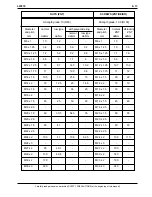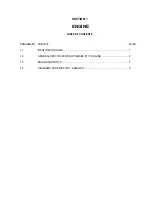
Carefully read personal and machine SAFETY PRECAUTIONS (at the beginning of this manual)
0 - 4
LW270
SAFETY RULES
unbuttoned or unzipped jackets that can get caught in
moving parts. Wear certified safety clothes such as: hard
hat, no-slip footwear, heavy gloves, ear protection, safety
glasses, reflector vests, respirators. Ask your employer
about specific safety equipment requirements.
Never service the machine with someone sitting in the
driver's seat, unless this person is an authorized operator
assisting in the maintenance being carried out.
Keep the operator’s compartment, step plates, grab rails
and handles clear of foreign objects, oil, grease, mud or
snow to minimize the danger of slipping or stumbling.
Clean mud or grease from your shoes before climbing on
the machine or driving it.
Never attempt to operate the machine or its attachments
from any position other than sitting in the operator’s seat.
Never stand under the boom.
Should it be necessary to move the attachment through
the hydraulic controls for maintenance purposes,
remember that this should be done while sitting in the
operator’s seat. Before starting the machine or moving its
attachment, apply the brakes, sound the horn and call that
you are about to maneuvre. Raise the attachment slowly.
Always lock the machine arms or any other parts that must
be lifted for maintenance purposes using adequate
external means. Do not allow any personnel to pass near
or even below a raised yet unlocked attachment. If you are
not absolutely sure about your safety, do not stay under a
raised attachment, even if it is locked.
Do not place body, limbs, or fingers near articulated cutting
edges of uncontrolled machine parts or deprived of the
necessary guards, unless they are suitably and safely
locked.
Never perform any work on the machine with the engine
running, except when this is specifically required. Do not
wear loose clothing, jewelery or such near moving parts.
When service or maintenance require access to areas that
cannot be reached from the ground, use a ladder or step
platform conforming to regulations in force. If such means
are not available, use machine grab rails and steps.
Always perform all service or maintenance work with the
greatest care and attention.
Shop and/or field service platforms or ladders should be
manufactured in accordance with safety regulations in
force.
Disconnect batteries and label all controls to warn that
service work is in progress. Block the machine and all
attachments to be raised.
Do not check or fill fuel tanks, batteries and accumulators,
nor use the starting liquid if you are smoking or near open
flames. These fluids are flammable!
BRAKES ARE INOPERATIVE when manually released
for servicing. Provisions must be made to maintain control
of the machine using suitable blocks or other means.
The fuel filler pipe nozzle must be constantly kept in contact
with the filler neck. Keep this contact from the beginning to
the end of the fuelling operation to avoid possible genera-
tion of sparks due to static electricity.
Tow the machine only from the attaching points provided.
Use care in making connections and ensure pins and/or
bolt are firmly secured before pulling. Stay clear of draw-
bars, cables or chains under load.
To move a failed machine, use a trailer or a low platform
truck, if available. In case towing is needed, use all
necessary signals required by local regulations, and follow
directions provided in this Manual.
Load/unload the machine from transporter on firm level
ground providing safe support to the wheels of the truck or
trailer. Use strong access ramps, with adequate height
and angle. Keep the loading platform free of mud, oil or
slippery materials.
Tie the machine securely to the platform of the truck or
trailer and opportunely wedge machine wheels or tracks
as required.
Never align holes or slots using your fingers; always use
appropriate aligning tools.
Remove all sharp edges and burrs from re-worked parts.
Use only approved and effectively grounded auxiliary
power sources for heaters, battery chargers, pumps and
similar equipment to reduce electrical shock hazard.
Lift and handle heavy components using hoisting devices
of appropriate capacity. Ensure the sling has been correctly
applied. Use lifting eyes if provided. Pay attention to
personnel.
Never pour gasoline or diesel fuel into open, wide and low
containers. Never use gasoline, solvents or other
flammable fluids to clean parts. Use proprietary certified
non-flammable, non-toxic solvents only.
When using compressed air to clean parts, wear safety
glasses with side shields. Limit pressure to maximum 2
bars (29.00 psi), in accordance with local safety regulations
in force.
Do not run the engine in closed buildings without proper
ventilation capable to remove lethal fumes.
Do not smoke, use open flames or produce sparks nearby
while refuelling the unit or handling highly flammable
materials.
Do not use any flame as a light source during maintenance
work or to look for leaks anywhere on the machine.
Make sure that all tools provided are in good condition at all
times. NEVER USE tools with mushroomed or damaged
heads. Always wear eye protections.
Move with extreme care when working under the machine,
its attachments, and even on or near them. Always wear
protective safety equipment as required, such as hard hat,
goggles, safety shoes, and ear plugs.
Summary of Contents for LW270
Page 1: ...Wheel Loaders LW270 SERVICE MANUAL ...
Page 11: ...PAGE LEFT INTENTIONALLY BLANK ...
Page 13: ...PAGE LEFT INTENTIONALLY BLANK ...
Page 27: ...PAGE LEFT INTENTIONALLY BLANK ...
Page 29: ...PAGE LEFT INTENTIONALLY BLANK ...
Page 31: ...This as a preview PDF file from best manuals com Download full PDF manual at best manuals com ...

































